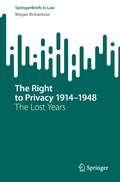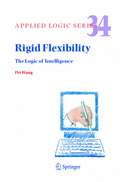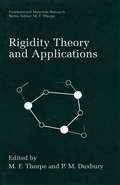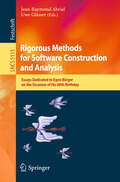- Table View
- List View
The Right to Erasure in EU Data Protection Law (Oxford Data Protection & Privacy Law)
by Jef AusloosThis book critically investigates the role of data subject rights in countering information and power asymmetries online. It aims at dissecting 'data subject empowerment' in the information society through the lens of the right to erasure ("right to be forgotten") in Article 17 of the General Data Protection Regulation (GDPR). In doing so, it provides an extensive analysis of the interaction between the GDPR and the fundamental right to data protection in Art.8 of the Charter of Fundamental Rights of the EU (Charter), how data subject rights affect fair balancing of fundamental rights, and what the practical challenges are to effective data subject rights. The book starts with exploring the data-driven asymmetries that characterise individuals' relationship with tech giants. These commercial entities increasingly anticipate and govern how people interact with each other and the world around them, affecting core values such as individual autonomy, dignity and freedom. The book explores how data protection law, and data subject rights in particular, enable resisting, breaking down or at the very least critically engaging with these asymmetric relationships. It concludes that despite substantial legal and practical hurdles, the GDPR's right to erasure does play a meaningful role in furthering the fundamental right to data protection (Art. 8 Charter) in the face of power asymmetries online.
The Right to Erasure in EU Data Protection Law (Oxford Data Protection & Privacy Law)
by Jef AusloosThis book critically investigates the role of data subject rights in countering information and power asymmetries online. It aims at dissecting 'data subject empowerment' in the information society through the lens of the right to erasure ("right to be forgotten") in Article 17 of the General Data Protection Regulation (GDPR). In doing so, it provides an extensive analysis of the interaction between the GDPR and the fundamental right to data protection in Art.8 of the Charter of Fundamental Rights of the EU (Charter), how data subject rights affect fair balancing of fundamental rights, and what the practical challenges are to effective data subject rights. The book starts with exploring the data-driven asymmetries that characterise individuals' relationship with tech giants. These commercial entities increasingly anticipate and govern how people interact with each other and the world around them, affecting core values such as individual autonomy, dignity and freedom. The book explores how data protection law, and data subject rights in particular, enable resisting, breaking down or at the very least critically engaging with these asymmetric relationships. It concludes that despite substantial legal and practical hurdles, the GDPR's right to erasure does play a meaningful role in furthering the fundamental right to data protection (Art. 8 Charter) in the face of power asymmetries online.
The Right to Privacy 1914–1948: The Lost Years (SpringerBriefs in Law)
by Megan RichardsonThe book offers a provocative review of thinking about privacy and identity in the years encompassing and disrupted by the two world wars of the first half of the twentieth century – focusing (in particular) on the socio-technological transformations associated with modernism. It argues that, with many of the most interesting modern thinkers of the period dead or marginalised (or both) by 1948, their ideas about how rights such as privacy should develop to accommodate the exigencies of modern life failed to find much of a voice in the drafting of the Universal Declaration of Human Rights. Yet they anticipated in surprising ways some of our ‘new’ ways of thinking in more recent times. After a brief introduction, the chapters are framed in terms of case studies on the right to privacy, the right to data protection and the right to be forgotten, each finishing with a consideration of how these rights require further rethinking in the digital century.
Righteous Indignation: Excuse Me While I Save The World
by Andrew Breitbart"Brash, funny, fiery, and irreverent." -- Rush Limbaugh Known for his network of conservative websites that draws millions of readers everyday, Andrew Breitbart has one main goal: to make sure the "liberally biased" major news outlets in this country cover all aspects of a story fairly. Breitbart is convinced that too many national stories are slanted by the news media in an unfair way. In Righteous Indignations, Breitbart talks about how one needs to deal with the liberal news world head on. Along the way, he details his early years, working with Matt Drudge, the Huffington Post, and how Breitbart developed his unique style of launching key websites to help get the word out to conservatives all over. A rollicking and controversial read, Breitbart will certainly raise your blood pressure, one way or another.
Rights for Intelligent Robots?: A Philosophical Inquiry into Machine Moral Status
by Kęstutis MosakasIn recent years, the question of human moral duties toward robots has gained momentum in scholarly research due to great advancements in the fields of artificial intelligence (AI) and robotics. Although the current machines fall short of the level of sophistication and human likeness portrayed in science fiction (e.g., the Westworld series or the movie Blade Runner 2049), they are increasingly assuming roles in our society in various important areas, including manufacturing, healthcare, education, customer service, entertainment, and many others. This book makes a meaningful contribution to the ongoing philosophical discourse surrounding the moral treatment of robots. By providing a rigorous and systematic examination of key moral concepts (e.g., moral rights, moral status, moral considerability, and moral value) within the context of robotics and exploring other closely related issues (e.g., the moral implications of artificial consciousness and the associated epistemic challenges), this book offers fresh insights into the necessary and sufficient conditions for machine moral status and rights.
Rightshore!: Successfully Industrialize SAP® Projects Offshore
by Anja Hendel Wolfgang Messner Frank ThunRightshore® - a registered trademark of Capgemini - is about organizing the distributed delivery process that embraces on-site, nearshore and offshore services. This book describes successful global delivery models utilizing industrialized methods to deliver SAP® projects from India. The first part is devoted to management concepts, service offerings and the peculiarities of working together with India. The second part features eight case studies from different industries and from around the world describing how India delivery centers have been successfully deployed in SAP® development projects.
Rigid Finite Element Method in Analysis of Dynamics of Offshore Structures (Ocean Engineering & Oceanography #1)
by Edmund Wittbrodt Marek Szczotka Andrzej Maczyński Stanisław WojciechThis book describes new methods developed for modelling dynamics of machines commonly used in the offshore industry. These methods are based both on the rigid finite element method, used for the description of link deformations, and on homogeneous transformations and joint coordinates, which is applied to the modelling of multibody system dynamics. In this monograph, the bases of the rigid finite element method and homogeneous transformations are introduced. Selected models for modelling dynamics of offshore devices are then verified both by using commercial software, based on the finite element method, as well as by using additional methods. Examples of mathematical models of offshore machines, such as a gantry crane for Blowout-Preventer (BOP) valve block transportation, a pedestal crane with shock absorber, and pipe laying machinery are presented. Selected problems of control in offshore machinery as well as dynamic optimization in device control are also discussed. Additionally, numerical simulations of pipe-laying operations taking active reel drive into account are shown.
Rigid Flexibility: The Logic of Intelligence (Applied Logic Series #34)
by Pei WangThis book is the most comprehensive description of the decades-long Non-Axiomatic Reasoning System (NARS) project, including its philosophical foundation, methodological consideration, conceptual design details, implications in the related fields, and its similarities and differences to many related works in cognitive science. While most current works in Artificial Intelligence (AI) focus on individual aspects of intelligence and cognition, NARS is designed and developed to attack the AI problem as a whole.
Rigidity Theory and Applications (Fundamental Materials Research)
by M. F. Thorpe P. M. DuxburyAlthough rigidity has been studied since the time of Lagrange (1788) and Maxwell (1864), it is only in the last twenty-five years that it has begun to find applications in the basic sciences. The modern era starts with Laman (1970), who made the subject rigorous in two dimensions, followed by the development of computer algorithms that can test over a million sites in seconds and find the rigid regions, and the associated pivots, leading to many applications. This workshop was organized to bring together leading researchers studying the underlying theory, and to explore the various areas of science where applications of these ideas are being implemented.
Rigidly Framed Earth Retaining Structures: Thermal soil structure interaction of buildings supporting unbalanced lateral earth pressures (Springer Series in Geomechanics and Geoengineering)
by Walid Aboumoussa Magued IskanderStructures placed on hillsides often present a number of challenges and a limited number of economical choices for site design. An option sometimes employed is to use the building frame as a retaining element, comprising a Rigidly Framed Earth Retaining Structure (RFERS). The relationship between temperature and earth pressure acting on RFERS, is explored in this monograph through a 4.5 year monitoring program of a heavily instrumented in service structure. The data indicated that the coefficient of earth pressure behind the monitored RFERS had a strong linear correlation with temperature. The study also revealed that thermal cycles, rather than lateral earth pressure, were the cause of failure in many structural elements.The book demonstrates that depending on the relative stiffness of the retained soil mass and that of the structural frame, the developed lateral earth pressure, during thermal expansion, can reach magnitudes several times larger than those determined using classical earth pressure theories. Additionally, a nearly perpetual lateral displacement away from the retained soil mass may occur at the free end of the RFERS leading to unacceptable serviceability problems. These results suggest that reinforced concrete structures designed for the flexural stresses imposed by the backfill soil will be inadequately reinforced to resist stresses produced during the expansion cycles.Parametric studies of single and multi-story RFERS with varying geometries and properties are also presented to investigate the effects of structural stiffness on the displacement of RFERS and the lateral earth pressure developed in the soil mass. These studies can aid the reader in selecting appropriate values of lateral earth pressure for the design of RFERS. Finally, simplified closed form equations that can be used to predict the lateral drift of RFERS are presented.KEY WORDS: Earth Pressure; Soil-Structure Interaction; Mechanics; Failure; Distress; Temperature; Thermal Effects; Concrete; Coefficient of Thermal Expansion; Segmental Bridges; Jointless Bridges; Integral Bridges; Geotechnical Instrumentation; Finite Element Modeling; FEM; Numerical Modeling.
Rigor in the Remote Learning Classroom: Instructional Tips and Strategies
by Barbara R. BlackburnLearn how to keep the rigor and motivation alive in a remote learning or hybrid K–12 classroom. In this essential book, bestselling author Barbara R. Blackburn shares frameworks and tools to help you move online without compromising the rigor of your instruction. You’ll learn… how to create a remote culture of high expectations; how to scaffold so students reach higher levels of learning; how to have students collaborate in different settings; and how to provide virtual feedback and deliver effective assessments. You’ll also discover how common activities, such as virtual field trips, can lack rigor without critical thinking prompts. The book provides practical strategies you can implement immediately to help all students reach higher levels of success.
Rigor in the Remote Learning Classroom: Instructional Tips and Strategies
by Barbara R. BlackburnLearn how to keep the rigor and motivation alive in a remote learning or hybrid K–12 classroom. In this essential book, bestselling author Barbara R. Blackburn shares frameworks and tools to help you move online without compromising the rigor of your instruction. You’ll learn… how to create a remote culture of high expectations; how to scaffold so students reach higher levels of learning; how to have students collaborate in different settings; and how to provide virtual feedback and deliver effective assessments. You’ll also discover how common activities, such as virtual field trips, can lack rigor without critical thinking prompts. The book provides practical strategies you can implement immediately to help all students reach higher levels of success.
Rigorous Development of Complex Fault-Tolerant Systems (Lecture Notes in Computer Science #4157)
by Michael Butler Cliff Jones Alexander Romanovsky Elena TroubitsynaThis book brings together 19 papers focusing on the application of rigorous design techniques to the development of fault-tolerant, software-based systems. It is an outcome of the REFT 2005 Workshop on Rigorous Engineering of Fault-Tolerant Systems held in conjunction with the Formal Methods 2005 conference at Newcastle upon Tyne, UK, in July 2005.
Rigorous Global Search: Continuous Problems (Nonconvex Optimization and Its Applications #13)
by R. Baker KearfottThis work grew out of several years of research, graduate seminars and talks on the subject. It was motivated by a desire to make the technology accessible to those who most needed it or could most use it. It is meant to be a self-contained introduction, a reference for the techniques, and a guide to the literature for the underlying theory. It contains pointers to fertile areas for future research. It also serves as introductory documentation for a Fortran 90 software package for nonlinear systems and global optimization. The subject of the monograph is deterministic, automatically verified or r- orous methods. In such methods, directed rounding and computational fix- point theory are combined with exhaustive search (branch and bound) te- niques. Completion of such an algorithm with a list of solutions constitutes a rigorous mathematical proof that all of the solutions within the original search region are within the output list. The monograph is appropriate as an introduction to research and technology in the area, as a desk reference, or as a graduate-level course reference. Kno- edge of calculus, linear algebra, and elementary numerical analysis is assumed.
Rigorous Methods for Software Construction and Analysis: Essays Dedicated to Egon Börger on the Occasion of His 60th Birthday (Lecture Notes in Computer Science #5115)
by Jean-Raymond Abrial Uwe GlässerA Rigorous Semantics for BPMN 2.0 Process Diagrams
by Felix Kossak Christa Illibauer Verena Geist Jan Kubovy Christine Natschläger Thomas Ziebermayr Theodorich Kopetzky Bernhard Freudenthaler Klaus-Dieter ScheweThis book provides the most complete formal specification of the semantics of the Business Process Model and Notation 2.0 standard (BPMN) available to date, in a style that is easily understandable for a wide range of readers – not only for experts in formal methods, but e.g. also for developers of modeling tools, software architects, or graduate students specializing in business process management.BPMN – issued by the Object Management Group – is a widely used standard for business process modeling. However, major drawbacks of BPMN include its limited support for organizational modeling, its only implicit expression of modalities, and its lack of integrated user interaction and data modeling. Further, in many cases the syntactical and, in particular, semantic definitions of BPMN are inaccurate, incomplete or inconsistent. The book addresses concrete issues concerning the execution semantics of business processes and provides a formal definition of BPMN process diagrams, which can serve as a sound basis for further extensions, i.e., in the form of horizontal refinements of the core language.To this end, the Abstract State Machine (ASMs) method is used to formalize the semantics of BPMN. ASMs have demonstrated their value in various domains, e.g. specifying the semantics of programming or modeling languages, verifying the specification of the Java Virtual Machine, or formalizing the ITIL change management process.This kind of improvement promotes more consistency in the interpretation of comprehensive models, as well as real exchangeability of models between different tools. In the outlook at the end of the book, the authors conclude with proposing extensions that address actor modeling (including an intuitive way to denote permissions and obligations), integration of user-centric views, a refined communication concept, and data integration.
Rigorous Software Development: An Introduction to Program Verification (Undergraduate Topics in Computer Science)
by José Bacelar Almeida Maria João Frade Jorge Sousa Pinto Simão Melo de SousaThe use of mathematical methods in the development of software is essential when reliable systems are sought; in particular they are now strongly recommended by the official norms adopted in the production of critical software. Program Verification is the area of computer science that studies mathematical methods for checking that a program conforms to its specification. This text is a self-contained introduction to program verification using logic-based methods, presented in the broader context of formal methods for software engineering. The idea of specifying the behaviour of individual software components by attaching contracts to them is now a widely followed approach in program development, which has given rise notably to the development of a number of behavioural interface specification languages and program verification tools. A foundation for the static verification of programs based on contract-annotated routines is laid out in the book. These can be independently verified, which provides a modular approach to the verification of software. The text assumes only basic knowledge of standard mathematical concepts that should be familiar to any computer science student. It includes a self-contained introduction to propositional logic and first-order reasoning with theories, followed by a study of program verification that combines theoretical and practical aspects - from a program logic (a variant of Hoare logic for programs containing user-provided annotations) to the use of a realistic tool for the verification of C programs (annotated using the ACSL specification language), through the generation of verification conditions and the static verification of runtime errors.
Rigorous Software Engineering for Service-Oriented Systems: Results of the SENSORIA Project on Software Engineering for Service-Oriented Computing (Lecture Notes in Computer Science #6582)
by Martin Wirsing Matthias HölzlService-Oriented Computing is a paradigm for developing and providing software that can address many IT challenges, ranging from integrating legacy systems to building new, massively distributed, interoperable, evaluable systems and applications. The widespread use of SOC demonstrates the practical benefits of this approach. Furthermore it raises the standard for reliability, security, and performance for IT providers, system integrators, and software developers. This book documents the main results of Sensoria, an Integrated Project funded by the European Commission in the period 2005-2010. The book presents, as Sensoria's essence, a novel, coherent, and comprehensive approach to the design, formal analysis, automated deployment, and reengineering of service-oriented applications. Following a motivating introduction, the 32 chapters are organized in the following topical parts: modeling in service-oriented architectures; calculi for service-oriented computing; negotiation, planning, and reconfiguration; qualitative analysis techniques for SOC; quantitative analysis techniques for SOC; model-driven development and reverse engineering for service-oriented systems; and case studies and patterns.
Rigorous State-Based Methods: 8th International Conference, ABZ 2021, Ulm, Germany, June 9–11, 2021, Proceedings (Lecture Notes in Computer Science #12709)
by Alexander Raschke Dominique MéryThis book constitutes the proceedings of the 8th International Conference on Rigorous State-Based Methods, ABZ 2021, which was planned to take place in Ulm, Germany, during June 6-11, 2021. The conference changed to an online format due to the COVID-19 pandemic. The 6 full and 8 short papers included in this volume were carefully reviewed and selected from 18 submissions. The proceedings also include 3 PhD symposium contributions. They deal with state-based and machine-based formal methods, mainly Abstract State Machines (ASM), Alloy, B, TLA+, VDM, and Z.
Rigorous State-Based Methods: 7th International Conference, ABZ 2020, Ulm, Germany, May 27–29, 2020, Proceedings (Lecture Notes in Computer Science #12071)
by Alexander Raschke Dominique Méry Frank HoudekThis book constitutes the refereed proceedings of the 7th International Conference on Rigorous State-Based Methods, ABZ 2020, which was due to be held in Ulm, Germany, in May 2020. The conference was cancelled due to the COVID-19 pandemic. The 12 full papers and 9 short papers were carefully reviewed and selected from 61 submissions. They are presented in this volume together with 2 invited papers, 6 PhD-Symposium-contributions, as well as the case study and 6 accepted papers outlining solutions to it. The papers are organized in the following sections: keynotes and invited papers; regular research articles; short articles; articles contributing to the case study; short articles of the PhD-symposium (work in progress).
Rigorous State-Based Methods: 10th International Conference, ABZ 2024, Bergamo, Italy, June 25–28, 2024, Proceedings (Lecture Notes in Computer Science #14759)
by Patrizia Scandurra Elvinia Riccobene Michael Leuschel Angelo Gargantini Silvia BonfantiThis book constitutes the refereed proceedings of the 10th International Conference on Rigorous State-Based Methods, ABZ 2024, held in Bergamo, Italy, during June 25–28, 2024. The 29 papers included in this volume were carefully reviewed and selected from 47 submissions. They were organized in topical sections as follows: research papers; short research papers; case study; doctoral symposium.
Ring Computer Network (large print)
by RnibThis is a diagram showing computers connected together in a ring network configuration. There is a locator dot shown, which will be at the top left of the page when the image is the right way up. The file server and each workstation are represented by rectangles. Arrows indicate the way data passes between them. The file server, shown in a striped texture, is at the top left of the page and is connected to workstation A to its right by a line. Moving in a clockwise direction around the page workstations B, C and D link back to the file server at the top left of the page.
Ring Computer Network (UEB contracted)
by RnibThis is a diagram showing computers connected together in a ring network configuration. There is a locator dot shown, which will be at the top left of the page when the image is the right way up. The file server and each workstation are represented by rectangles. Arrows indicate the way data passes between them. The file server, shown in a striped texture, is at the top left of the page and is connected to workstation A to its right by a line. Moving in a clockwise direction around the page workstations B, C and D link back to the file server at the top left of the page.
Ring Computer Network (UEB uncontracted)
by RnibThis is a diagram showing computers connected together in a ring network configuration. There is a locator dot shown, which will be at the top left of the page when the image is the right way up. The file server and each workstation are represented by rectangles. Arrows indicate the way data passes between them. The file server, shown in a striped texture, is at the top left of the page and is connected to workstation A to its right by a line. Moving in a clockwise direction around the page workstations B, C and D link back to the file server at the top left of the page.
Ring Theory
by Dinesh Khattar Neha AgrawalThis textbook is designed for the UG/PG students of mathematics for all universities over the world. It is primarily based on the classroom lectures, the authors gave at the University of Delhi. This book is used both for self-study and course text. Full details of all proofs are included along with innumerous solved problems, interspersed throughout the text and at places where they naturally arise, to understand abstract notions. The proofs are precise and complete, backed up by chapter end problems, with just the right level of difficulty, without compromising the rigor of the subject. The book starts with definition and examples of Rings and logically follows to cover Properties of Rings, Subrings, Fields, Characteristic of a Ring, Ideals, Integral Domains, Factor Rings, Prime Ideals, Maximal Ideals and Primary Ideals, Ring Homomorphisms and Isomorphisms, Polynomial Rings, Factorization of Polynomials, and Divisibility in Integral Domains.




















